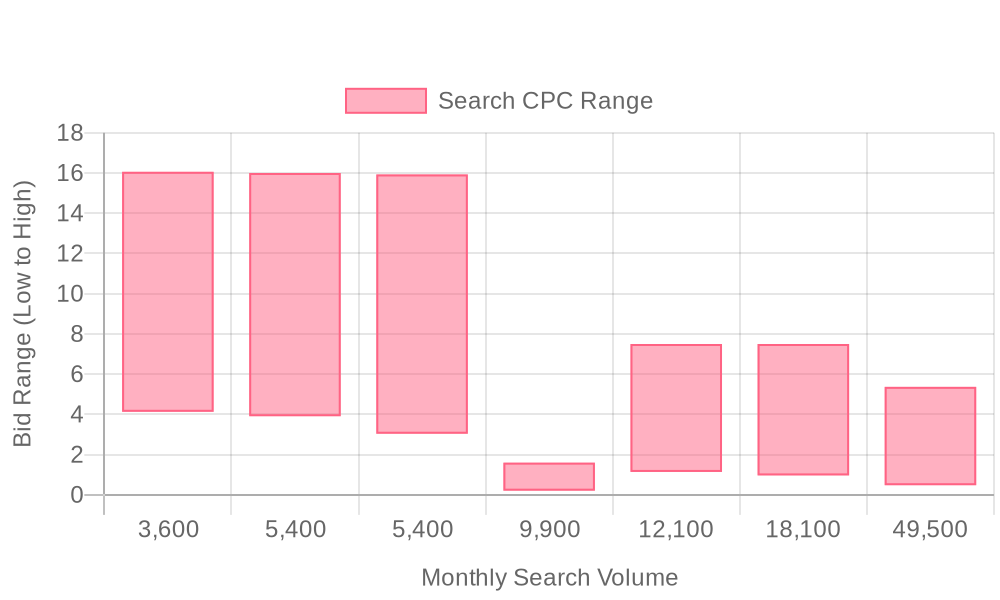
Supercharge your lead generation with a FREE Google Ads audit - no strings attached! See how you can generate more and higher quality leads
Get My Free Google Ads AuditFree consultation

No commitment
Supercharge your lead generation with a FREE Google Ads audit - no strings attached! See how you can generate more and higher quality leads
Get My Free Google Ads AuditFree consultation

No commitment
In today's competitive landscape, leveraging Google Ads can be a game-changer for tile and grout cleaning businesses aiming to stand out in the digital space. As a pivotal tool within a multi-channel marketing framework, Google Ads offers the ability to target decision-makers precisely when they're searching for solutions, bridging the gap between broader awareness efforts and your direct sales process. With the right approach, you'll capture high-intent prospects, overcoming challenges like lack of visibility into anonymous traffic and ensuring your marketing efforts are more effective, ultimately improving ROI.

Tile and grout cleaning businesses thrive when their marketing strategies are grounded in actionable data rather than guesswork. By leveraging advanced audience insights and precise campaign tracking, marketers can consistently attract ready-to-book leads without wasted spend or missed opportunities.
Implement these steps to drive high-value leads and maintain consistent growth in a highly competitive market:
This approach streamlines lead generation for tile and grout cleaning companies, delivering measurable growth and sustained customer acquisition in markets where every lead counts. To accelerate your results, get started for free with Sona.

Tile and grout cleaning providers operate in a highly specialized industry where every qualified lead can represent significant revenue. Effective digital marketing must reach homeowners and facilities managers precisely when they are searching for urgent, high-margin cleaning solutions. Google Ads delivers an immediate channel to tap into that intent-rich demand, driving leads while competitors rely on slow-moving referrals or generic outreach. For more strategies to amplify your digital reach, explore our marketing analytics blog.

A modern tile and grout cleaning business thrives on precise digital targeting and measurable engagement. Each Google Ads campaign type plays a unique role in the customer journey, from initial discovery to closing the loop on repeat business. Selecting the right mix of campaign formats is essential for moving prospects efficiently through your funnel and ensuring marketing spend drives both short-term bookings and long-term brand value. To learn more about optimizing your ad strategy, explore this ultimate guide to B2B marketing reports.
Each of these campaign types, when connected through unified data and dynamic audience management, allows tile and grout cleaning businesses to maximize every advertising dollar and build a steady pipeline of qualified, high-value leads. Ready to see how these strategies can drive real results? Get started for free with Sona.

Tile and grout cleaning businesses can unlock significant growth by aligning digital marketing strategies with evolving customer needs. Data-driven analysis of market trends and search behavior enables organizations to capture demand with greater precision and outpace local competitors. Discover the latest professional tile and grout cleaning services to understand industry standards, and explore our blog for actionable insights on marketing analytics and growth.
Modern cleaning businesses unlock higher conversion rates and lower acquisition costs by segmenting audiences with precision. Distinct audience groups enable campaigns to reach residential homeowners and commercial property managers with tailored messaging and offers, creating a direct path from search to service request. For a deeper dive into building real-time, signal-based segments for highly targeted outreach, explore precise audience intelligence.
Integrating granular segmentation with real-time insights allows cleaning businesses to maintain a competitive edge in digital advertising. By identifying high-value visitors, syncing enriched audience data into connected ad platforms, and measuring performance across every stage of the customer journey, revenue teams achieve a unified view of campaign impact and optimize for true ROI. Ready to streamline your audience targeting? Get started for free with Sona.

| Industry | Keyword | Monthly Search Volume | Competition Level | Low Bid | High Bid |
| Tile And Grout Cleaning | tile cleaning service | 3600 | LOW | 4.13 | 16.06 |
| Tile And Grout Cleaning | grout cleaning service | 5400 | MEDIUM | 3.91 | 16 |
| Tile And Grout Cleaning | tile cleaning near me | 5400 | LOW | 3.04 | 15.93 |
| Tile And Grout Cleaning | best grout cleaner | 9900 | HIGH | 0.21 | 1.6 |
| Tile And Grout Cleaning | tile cleaning | 12100 | HIGH | 1.14 | 7.5 |
| Tile And Grout Cleaning | tile and grout cleaning | 18100 | MEDIUM | 0.97 | 7.5 |
| Tile And Grout Cleaning | grout cleaner | 49500 | HIGH | 0.48 | 5.37 |
Selecting high-impact keywords is at the core of any successful Google Ads for tile and grout cleaning campaign. Precision in keyword targeting determines not only the reach of your ads but also the quality of leads generated. To maximize PPC for cleaning services, focus on terms that map directly to commercial intent and reflect the most urgent needs of homeowners, facility managers, and local businesses seeking grout restoration or deep tile cleaning.
A rigorous campaign execution framework is essential for tile and grout cleaning businesses aiming to capture high-intent leads, outpace local competitors, and drive measurable ROI from digital campaigns. With the right structure, marketing teams can unify data, sharpen targeting, and create a repeatable system for lead generation that adapts to shifting market demand. Explore actionable guidance in the Sona playbooks library to strengthen your campaign approach.
This framework aligns each critical step with the unique challenges and opportunities in the tile and grout cleaning space, ensuring your campaigns are not just visible but also highly effective in converting search demand into booked jobs and long-term clients.
Success in Google Ads for tile and grout cleaning starts with a granular approach to keyword selection. Incorporate city and neighborhood modifiers to reach users searching for local services, such as “tile cleaning in Chicago” or “grout restoration Los Angeles.” Long-tail queries, like “how to remove stains from bathroom grout” or “best commercial tile cleaning near me,” capture high-value intent and filter out low-converting traffic. For a list of high-converting keywords to power your campaigns, refer to this cleaning services keywords resource.
Negative keywords are critical. Exclude terms related to DIY, home remedies, or unrelated flooring types to prevent wasted spend and improve lead quality. By connecting campaign keywords with ongoing precise audience intelligence, marketers can continuously refine match types and negative lists as real-world search behaviors shift. When using advanced visitor identification, marketers can see which companies and individuals are interacting with ads, enabling even more precise keyword expansion and exclusion strategies over time.
Effective tile cleaning ads must resonate immediately with the pain points of residential and commercial clients. Headlines should call out urgent needs—like stubborn grout stains or recurring tile discoloration—using narrative hooks that mirror the problems your ideal customers face. Distinctive ad copy positions your service as the optimal solution, addressing both speed (“same-day grout cleaning”) and thoroughness (“removes 99% of bacteria”).
Calls to action must be direct and time-sensitive: “Book Your Free Estimate Today” or “Restore Your Floors This Week.” Trust is built through visible guarantees, years-in-business claims, and customer testimonials. As campaigns run, real-time intent signals on ad engagement and audience segments can inform copy tweaks—optimizing for what actually drives clicks and conversions in your local markets. Syncing ad performance with person-level insights ensures that ads evolve to match the priorities and objections of your best prospects. For practical inspiration, see advertising examples from professional tile and grout cleaning services.
A seamless experience between ad and landing page is non-negotiable for top conversion rates in tile and grout cleaning marketing. Each landing page should be tightly aligned with the keywords and ad copy that drove traffic: if an ad promises “eco-friendly grout restoration in Dallas,” the landing page must reinforce that promise and deliver clear proof points.
ROI assurances—such as “100% satisfaction guarantee” or “free re-clean if not happy”—instill confidence. Simple, mobile-friendly contact forms and click-to-call buttons reduce friction, making it easy for visitors to book or request a quote. Data-driven teams leverage advanced identification and attribution, connecting each landing page visit to specific campaigns and audience segments, allowing for continuous optimization based on which CTAs and layouts are converting specific buyer groups. To see how to get started with seamless lead tracking and campaign alignment, get started for free with Sona.
Campaign performance in the tile and grout cleaning industry is never static. Use Google’s optimization tools to monitor conversion rates, adjust bidding, and deploy automated rules that prioritize high-performing ads and keywords. Real-time intent signals—such as repeated visits, high engagement, or new company-level interest—should trigger budget reallocations toward the most promising accounts.
Integrating person-level identification enables better segmentation and allows campaigns to adapt as prospects move from awareness to evaluation. Syncing CRM and ad audiences ensures no high-value lead slips through the cracks: audiences update dynamically, so remarketing and lookalike campaigns target only the most engaged, sales-ready contacts. This results in more efficient spend and higher ROI, as every optimization is grounded in unified, actionable data rather than guesswork. For additional tips on campaign improvement, explore this overview of optimizing Google Ads for cleaning companies.

Maximizing your tile and grout cleaning business's reach requires a blend of digital visibility, customer engagement, and local authority. Strategic growth is achieved through orchestrated efforts that align marketing, sales, and operational data, allowing for meaningful connections and profitable outcomes.
Harnessing the full potential of digital marketing for tile and grout cleaning hinges on precise targeting, dynamic audience management, and seamless integration between CRM and ad platforms. To see how you can apply these strategies and drive sustainable growth, get started for free with Sona.
Effectively leveraging Google Ads can transform your tile and grout cleaning business, making it a powerhouse of customer attraction and engagement. Throughout this article, we explored the fundamental strategies for optimizing your ad campaigns, ensuring your services stand out in a competitive market. From understanding keyword selection to crafting compelling ads, these insights are designed to elevate your advertising efforts.
We addressed the common challenges faced by tile and grout cleaning services, such as reaching the right audience and maximizing ad spend efficiency. By implementing a strategic approach to Google Ads, aligning with best practices, and continuously analyzing performance, you can significantly improve your advertising results. These steps are crucial for increasing visibility and driving more leads to your business.
Imagine the possibilities when your cleaning services reach the ideal audience at the perfect time. With the right tools and strategies, you can transform your business landscape, achieving greater success and operational efficiency. Take the insights shared here and apply them to your campaigns, knowing that growth and improved performance are within reach.
To experience a seamless integration of these strategies, start for free and discover how our platform can enhance your advertising capabilities today.
Best practices include developing a data-driven approach, focusing on relevant keywords and audience targeting, ensuring creative alignment, regularly optimizing performance, and integrating cross-channel methods.
Optimize by using precise keyword targeting, aligning ads and landing pages, implementing data-driven optimizations, and leveraging real-time audience insights.
Target keywords like 'tile cleaning ads', 'grout cleaning marketing', 'emergency grout repair', and use location-based modifiers to capture local traffic.
The budget should be allocated based on data-driven insights to target high-likelihood prospects and should be flexible to shift towards high-performing segments.
Avoid using generic, broad-match keyword strategies, mismatched ad experiences, and failing to regularly review and optimize campaigns.
Join results-focused teams combining Sona Platform automation with advanced Google Ads strategies to scale lead generation

Connect your existing CRM

Free Account Enrichment

No setup fees
No commitment required

Free consultation

Get a custom Google Ads roadmap for your business
Join results-focused teams using Sona Platform automation to activate unified sales and marketing data, maximize ROI on marketing investments, and drive measurable growth

Connect your existing CRM

Free Account Enrichment

No setup fees
No commitment required

Free consultation

Get a custom Google Ads roadmap for your business
Over 500+ auto detailing businesses trust our platform to grow their revenue
Join results-focused teams using Sona Platform automation to activate unified sales and marketing data, maximize ROI on marketing investments, and drive measurable growth

Connect your existing CRM

Free Account Enrichment

No setup fees
No commitment required

Free consultation

Get a custom Google Ads roadmap for your business
Over 500+ auto detailing businesses trust our platform to grow their revenue
Join results-focused teams using Sona Platform automation to activate unified sales and marketing data, maximize ROI on marketing investments, and drive measurable growth

Connect your existing CRM

Free Account Enrichment

No setup fees
No commitment required

Free consultation

Get a custom Google Ads roadmap for your business
Over 500+ auto detailing businesses trust our platform to grow their revenue
Join results-focused teams using Sona Platform automation to activate unified sales and marketing data, maximize ROI on marketing investments, and drive measurable growth

Connect your existing CRM

Free Account Enrichment

No setup fees
No commitment required

Free consultation

Get a custom Google Ads roadmap for your business
Over 500+ auto detailing businesses trust our platform to grow their revenue
Our team of experts can implement your Google Ads campaigns, then show you how Sona helps you manage exceptional campaign performance and sales.
Schedule your FREE 15-minute strategy sessionOur team of experts can help improve your demand generation strategy, and can show you how advanced attribution and data activation can help you realize more opportunities and improve sales performance.
Schedule your FREE 30-minute strategy sessionOur team of experts can help improve your demand generation strategy, and can show you how advanced attribution and data activation can help you realize more opportunities and improve sales performance.
Schedule your FREE 30-minute strategy sessionOur team of experts can help improve your demand generation strategy, and can show you how advanced attribution and data activation can help you realize more opportunities and improve sales performance.
Schedule your FREE 30-minute strategy sessionOur team of experts can help improve your demand generation strategy, and can show you how advanced attribution and data activation can help you realize more opportunities and improve sales performance.
Schedule your FREE 30-minute strategy session





Launch campaigns that generate qualified leads in 30 days or less.
